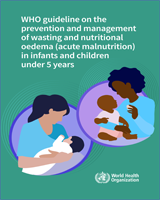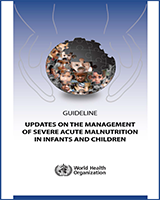This guideline was developed in accordance with the WHO evidence-informed guideline development procedures, as outlined in the WHO handbook for guideline development (3).
In summary, this involved:
Identification of priority questions and outcomes – the Nutrition Guidance Advisory Group comprised content experts, methodologists, representatives of potential stakeholders and consumers (see
Annex 3). They met in Geneva, Switzerland on 2–4 June 2010 and formulated the questions to be examined through systematic reviews. The group prioritized the areas of clinical care for which updated guidance is needed and identified what evidence was needed as being critical for decision-making and what other evidence was important or not essential for decision-making.
Systematic reviews were subsequently commissioned to retrieve relevant evidence for guideline development. Academic groups were identified that were experienced in evidence retrieval, assessment and synthesis. Primary authors provided declarations of interest.
Evidence identified in the systematic reviews for any given outcome was assessed. In brief, GRADE categorizes the quality of evidence as high, moderate, low or very low. These quality ratings apply to the body of evidence assessed for the PICO question,
1 not to individual studies. In general, evidence based on randomized controlled trials is given a high quality rating and evidence from observational studies is given a low quality rating. These initial ratings can be adjusted by the following factors:
study limitations such as concealment, blinding, type of analysis;
consistency, namely whether the results from the different studies are similar and in the same direction of effect;
directness, namely whether the population, intervention or comparator are the same as for the guideline under consideration;
imprecision, namely whether data arise from a large or small population;
reporting bias, namely whether there is a systematic underestimate or overestimate of the underlying beneficial or harmful effect due to the selective publication of studies or selective reporting of outcomes.
Other considerations, such as dose–response gradients, direction of plausible bias and magnitude of effect are also important.
Comments related to the domains that inform the assessment of the quality of evidence for each outcome are presented with respective GRADE tables.
Findings of research identified through this process were synthesized as GRADE tables (see Annex 1). GRADE tables were formulated only for outcomes that had been ranked as critical by the Nutrition Guidance Advisory Group. Data related to important outcomes were summarized in the narrative. In view of the paucity of data from randomized trials and the heterogeneity of definitions and interventions, it was not possible in most instance to undertake meta-analyses of results. Instead, findings from relevant studies are included in the tables.
Formulation of recommendations, including future research priorities
Draft recommendations are prepared by WHO staff. Following presentation of the systematic reviews, the Nutrition Guidance Advisory Group reviewed the draft recommendation and determined whether it is supported by the evidence. NUGAG and the external resources people met for this purpose on 2–4 June 2010, 14–16 March 2011 and 1–3 February 2012. In addition, the group considered: (i) desirable and undesirable effects of this intervention; (ii) the quality of the available evidence; (iii) values and preferences related to the intervention in different settings; and (iv) cost. The cost of options available to health-care workers in different settings was not formally assessed, owing to lack of primary data in the literature or elsewhere. However, cost implications were considered as part of general discussion by the Nutrition Guidance Advisory Group . There were no primary costing data included in the literature reviewed and hence comments were restricted to personal experiences and extrapolations from general cost considerations of programmes. The Nutrition Guidance Advisory Group also allocated a strength of recommendation, strong or conditional, which is reported as part of the guideline.
Advisory groups
A WHO Steering Committee for Nutrition Guidelines Development, led by the Department of Nutrition for Health and Development, was established in 2010, with representatives from all WHO departments with an interest in the provision of scientific nutrition advice. The steering committee guided the development of this guideline and provided overall supervision of the guideline development process (Annex 2).
The Nutrition Guidance Advisory Group – Subgroup on Nutrition in the Life Course and Undernutrition (Annex 3) included experts from various WHO expert advisory panels and experts in the area of undernutrition and other disciplinary areas of expertise, taking into consideration a balanced sex mix, and representation from all WHO regions. Efforts were made to include content experts, methodologists, representatives of potential stakeholders (such as managers and other health professionals involved in the health-care process) and consumers. Representatives of commercial organizations may not be members of a WHO guideline group. The role of the guideline group was to advise WHO on the choice of important outcomes for decision-making and the interpretation of the evidence.
The group of external experts and key stakeholders (Annex 4) were identified through a call for public comments and commented on the wording of the recommendations and were asked to highlight any missing evidence.
Scope of the guideline, evidence appraisal and decision-making
A Nutrition Guidance Advisory Group meeting, convened in June 2010 in Geneva, Switzerland, prioritized the need for updating the guideline on the management of severely malnourished children. An initial set of questions to be addressed in the guideline was the critical starting point for formulating the recommendations; the questions were drafted by technical staff of the Department of Nutrition for Health and Development and the Nutrition Guidance Advisory Group, in collaboration with the World Food Programme, UNICEF and the Office of the United Nations High Commissioner for Refugees, based on policy and programme guidance needs of Member States and their partners. A risk–benefit format was used (Annex 5).
Two other Nutrition Guidance Advisory Group meetings were held on 14–16 March 2011 and 1–3 February 2012, in Geneva, Switzerland, to review the evidence and discuss the draft recommendation, taking into consideration: (i) desirable and undesirable effects of these formulations; (ii) the quality of the available evidence; (iii) values and preferences related to the intervention in different settings; and (iv) the cost of options available to programme managers in different settings (Annex 5). Consensus was defined as agreement by the simple majority of the guideline group members (Annex 3). WHO staff present at the meeting, as well as other external technical experts involved in the collection and review of the evidence, were not allowed to vote. There were no strong disagreements among the Nutrition Guidance Advisory Group members.
A public call for comments on the final draft guideline was then released. All interested stakeholders became members of the External Experts and Stakeholders Panel but were only allowed to comment on the draft guideline after submitting a signed Declaration of Interests form. Respondents were asked to comment on the clarity of the recommendations; on any additional evidence that might not have been included; and whether any of the recommendations were in conflict with the evidence base. Feedback was received from 20 stakeholders and external experts. WHO staff then finalized the guideline and submitted it for clearance by WHO before publication.
Management of conflicts of interest
According to the rules in the WHO Basic documents (166), all experts participating in WHO meetings must declare any interest relevant to the meeting prior to their participation. The Declarations of Interest statements from all Nutrition Guidance Advisory Group members were reviewed by the responsible technical officer and the relevant departments before finalization of the group composition and invitation to attend a Nutrition Guidance Advisory Group meeting. All Nutrition Guidance Advisory Group members and participants of the guideline development meetings submitted a Declaration of Interests form, along with their curriculum vitae before each meeting. In addition, they verbally declared potential conflicts of interest at the beginning of each meeting. The procedures for management of conflicts of interests strictly followed the WHO Guidelines for declaration of interests (WHO experts) (167). The potential conflicts of interest declared by members of the guideline group are summarized below.
Dr Paluku Bahwere is a medical doctor with over 20 years' experience in the fields of public health, paediatrics, nutrition and HIV/AIDS. He declared being the Valid International's research focal person until August 2010. Through operational research and the development and implementation of evidence-based approaches, Valid International is committed to increasing the impact of humanitarian action. Valid International provides specialized advisers to support programme implementation, evaluate programme impact and research humanitarian and development techniques. He has personally been involved in a wide range of research projects, including the integration of community treatment centres with other child survival strategies; the use of ready-to-use foods for HIV-positive adults; and the use of community treatment centres for providing HIV services and managing malnutrition in HIV-infected children and adults. Dr Bahwere clarified that through his work with Valid International, he had no connection with Valid Nutrition, an Irish-registered charity that makes a range of ready-to-use therapeutic food in Africa and that is linked to Valid International. It was considered that Dr Bahwere's work with Valid International would be reported in the guideline.
Dr André Briend has extensive experience as researcher, programme manager and paediatrician. He was a member of technical staff in the Department of Child and Adolescent Health and Development WHO until 2010 and currently works as an independent consultant. Dr Briend was involved in development of the patent of the ready-to-use therapeutic food plumpy nut. He does not, however, own his product rights, and does not receive any royalties. The patent of the product belongs to Nutriset and Institut de Recherche pour le Développement. It was agreed that this would be reported in the guideline.
Dr Mark Manary is Professor of Paediatrics at Washington University St Louis School of Medicine, United States of America. He is also director of the Global Harvest Alliance, a joint venture between the St Louis Children's Hospital and the Donald Danforth Plant Science Center. Dr Manary's research interests focus on different aspects of nutrition in populations of developing countries, especially in Malawi, Africa. He has declared that in the last 3 years he has been in the academic field and is founder of the nongovernmental organization Peanut Butter, which produces ready-to-use therapeutic food for use in programmes in Malawi and Sierra Leone. Peanut Butter is a charitable project, which sells the ready-to-use therapeutic food on a cost-recovery basis to governments and agencies, which in turn distribute it free of charge to malnourished children. It was considered that Dr Manary's work on the humanitarian Project Peanut Butter would be reported in the guideline.
External resource persons were invited to the meetings as observers and to provide technical input, but they did not participate in the decision-making processes.
- 1
PICO is an acronym that describes the elements of a well-formed clinical question. These include patient/population, intervention, control, outcomes.


